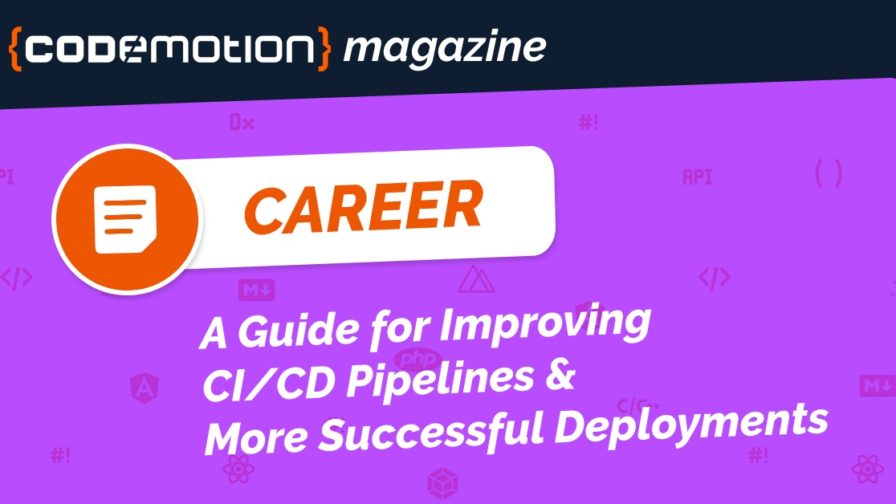
As a software engineer or developer, delivering new code or making improvements to existing code, is very much your bread and butter. Getting through this process is something that has changed astronomically as the developments in automation have accelerated over the last 20 years.
But, with this increased innovation comes the very real possibility of people struggling to keep up. Or not knowing the best way to go about working within their more automated system.
Throughout this article, we’ll take a look at the key elements which make up the modern DevOps pipeline. Once we’ve looked at these elements, we’ll also share some handy tips.
These are geared towards ensuring that your operation, or pipeline, runs as efficiently as possible. As, when your process is running smoothly, your job becomes so much easier. It also means your areas of concern are significantly reduced.
Definition Refresh:
So, to begin with, let’s set about defining some terms. Whilst the tips that come later in the post are the reason for writing it, we need to make sure we’re all on the same page, to begin with.
CI (Continuous Integration) refers to the process of developing, updating, and releasing applications by merging your code changes into a central repository, which works quite like a cloud phone system, housing the hub at the centre.
Once you’ve done this, you can run automated builds and tests to make sure that each integration has been successful.
CD (Continuous Deployment) is sometimes referred to as Continuous Delivery, but these terms are interchangeable. Generally speaking, in a linear context, where CI ends, CD begins. Continuous Deployment takes the testing data delivered by CI and puts this into production.
In the context of this article, the pipeline refers to the linking up of CI and CD as a process. Thus, the tips that we will share in this article are centred around making this pipeline a more smoothly operating one.
A smoothly running CI/CD pipeline operates like a VoIP for business phone system, reducing the need for the cables (manual interventions) of yesteryear.
In doing so, the whole process of DevOps should also improve, and the results you achieve are likely to be better and more efficient.
Because, regardless of how effective your team is, the more human contact introduced into this process, the greater the chance of human error.
So now, we’ll share some key tips on how to ensure your pipeline is running as efficiently and as free from human interference as possible.
Tip #1: Be Specific on Testing
Specificity in a tech-based scenario is vital. It’s difficult to achieve anything in this area of web development without knowing exactly what it is you’re building. This attitude should extend to every facet of your work. In particular, the area of testing.
The CI stage of your work is, by design, a time for testing things out. During the CI phase, you’re introducing a new element and ensuring that little to no damage is done to existing code as a result.
As well as this, you’re also looking to ensure that the new code makes the improvement or adjustment that you desire. Just like introducing new programming software or a new device management programme, you need to know what changes you expect, and how they will affect your wider organisation.
Carrying out this process without being specific about what it is you are looking for and when it should be making this change can make the CI stage much more inefficient. To optimise this even further, consider eliminating pre-existing tests that offer little to no value to you.
This ensures that your overall testing programme is as coherent as possible, whilst also delivering specific data for use in your test results.
Tip #2: Security
So, with all that out of the way, how do you go about ensuring that your deployment pipeline is operating at maximum efficiency? Well, a good place to start is by ensuring that your process is as secure as possible.
In today’s golden age of tech, hacking is rife. And the reality is that we never know what is around the corner. You can have the highest spec business continuity management (BCM) software available, but natural disasters, disruption caused by a global pandemic, or the concentrated attack of a team of hackers can arise at any time.
Caption: Ensuring that your network and, by extension, your CI/CD pipeline is secure from hackers from around the world is vital to ensuring success.
From video conferencing hardware to an intranet of sensitive materials, businesses require a secure network to operate effectively. Failure to create one can mean that your entire deployment process is available to anyone intent on hacking you.
The most effective way to secure your CI/CD pipeline at present is through the use of Virtual Private Networks (VPNs). These technologies allow you to divide your pipeline into sections, meaning that you don’t have to shut the entire network down should an attack take hold.
They also allow for you to place restrictions on the traffic going through the pipeline at any time, restricting the possibility of any malicious attacks, and helping to isolate any, should they take place. Limiting security permissions to essential staff only also helps in preventing potential in-house attacks.
Tip #3: Faster Build, Easier Fix
If the name of the game is efficiency, then building a process where fixing issues becomes quicker must be the goal, right? Well, in order to do this, think about how your entire code development cycle operates.
Breaking this down into smaller fractions, much as we suggested with the security tip above, and splitting segments like builds into different parts could be the answer here. You’d still be able to run the same tests on these builds, just run them in parallel.
Think of it like an IT help desk system which labels and monitors everything, ensuring you can keep track of everything, from the largest to the smallest detail.
If the whole cycle of your development is shorter, returning to problems that arise becomes easier, as there is less that could be causing the issue.
It’s an indirect way of making the entire DevOps process more minutely focussed, and, as a result, makes the entire thing easier to fix and, overall, just more efficient.
Conclusion
Throughout this article, we’ve looked at the different elements that make up the CI/CD pipeline. And we’ve provided a guide on how a few small changes can make a difference to the efficiency of your operation, and the success of your deployments.
Getting this right is definitely not easy, but it is an essential element of the struggle to optimise your company’s performance.
These tips are all fairly general, and adapting them to your processes will need some context and personalisation. As a foundation, though, they may be the key to unlocking the potential of your DevOps system.




